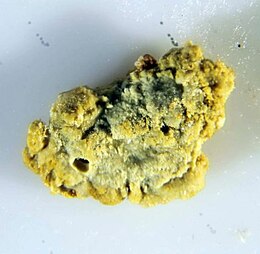Tugarinovite is a rare molybdenum oxide mineral with formula MoO2. It occurs as a primary mineral phase associated with metasomatism in a sulfur deficient reducing environment. In the type locality it occurs with uraninite, molybdenite, galena, zircon and wulfenite.[2]
| Tugarinovite | |
|---|---|
 Tugarinovite | |
| General | |
| Category | Oxide mineral |
| Formula (repeating unit) | MoO2 |
| IMA symbol | Tug[1] |
| Strunz classification | 4.DB.05 |
| Crystal system | Monoclinic |
| Crystal class | Prismatic H-M symbol (2/m) |
| Space group | P21/c (no. 14) |
| Unit cell | a = 5.6 Å, b = 4.85 Å, c = 5.53 Å; β = 119.37° |
| Identification | |
| Color | Dark lilac-brown |
| Crystal habit | Crystals are tabular striated prisms |
| Twinning | Polysynthetic |
| Mohs scale hardness | 4.6 |
| Luster | Greasy to metallic |
| Streak | Greenish gray |
| Diaphaneity | Semitransparent |
| Specific gravity | 6.58 (calculated) |
| Optical properties | Biaxial |
| Pleochroism | Light gray to dark pink; pale yellow to bluish olive-brown in reflected light |
| References | [2][3][4] |
Tugarinovite was first described for an occurrence in the Lenskoye molybdenum–uranium deposit in the Amurskaya Oblast, Far-Eastern Region, Russia. It was named for geochemist Ivan Alekseevich Tugarinov of the Vernadskii Institute in Moscow.[2][3] In addition to its type locality in Russia it has been reported from the Allende meteorite in Chihuahua, Mexico, the Nansei Archipelago of Japan and Bohemia in the Czech Republic.[3]
References
edit- ^ Warr, L.N. (2021). "IMA–CNMNC approved mineral symbols". Mineralogical Magazine. 85 (3): 291–320. Bibcode:2021MinM...85..291W. doi:10.1180/mgm.2021.43. S2CID 235729616.
- ^ a b c Handbook of Mineralogy
- ^ a b c Tugarinovite on Mindat.org
- ^ Tugarinovite on Webmin